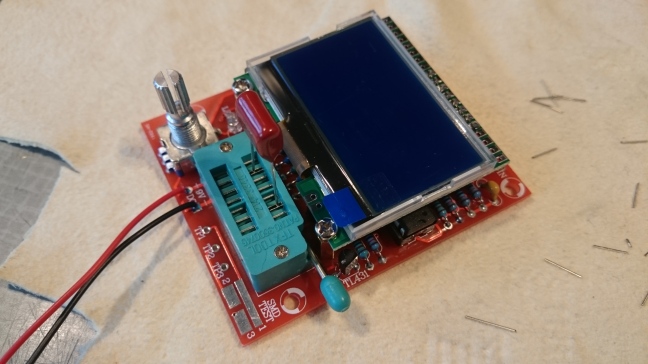As I am in the process of rebuilding an DAC from the scratch, I figured out that I will match the components in its analog amplification stage. The analog stage consists of a i-v (current to voltage) converter, with a couple of classic NPN and PNP transistors. These components do vary alot when it comes to the amplification level, hFE / B. The result might be different amplitude on the two channels.
 On Ebay I found a little DIY device that could help me test theperformance of various transistors and other components. In the first picture you can see the finished unit, the blue-greenish slot is where the components is inserted. The device has tree test pins, and inserting a transistor in any way to these pins, it will identify the component and some parameters just by pressing the encoder button. It can also test capacitor ESR, diodes, zener-diodes, FET transistors, and so on. The accuracy is of course debartable, so I will test the transistors in other ways to verify.
On Ebay I found a little DIY device that could help me test theperformance of various transistors and other components. In the first picture you can see the finished unit, the blue-greenish slot is where the components is inserted. The device has tree test pins, and inserting a transistor in any way to these pins, it will identify the component and some parameters just by pressing the encoder button. It can also test capacitor ESR, diodes, zener-diodes, FET transistors, and so on. The accuracy is of course debartable, so I will test the transistors in other ways to verify.
 This is all the parts that came in the packet. The circuit board tells you where each component is going, with the value or name of each part. The unit is based upon a Atmega328, just like the Arduino! After soldering, the board was cleaned with a solvent, I found that brake cleaner works quite well.
This is all the parts that came in the packet. The circuit board tells you where each component is going, with the value or name of each part. The unit is based upon a Atmega328, just like the Arduino! After soldering, the board was cleaned with a solvent, I found that brake cleaner works quite well.
Here are some building pic’s, halfway in the process. I use a small screwdriver to make a smooth bend on the legs. I always double check the component, and sometimes even measure it to make shure it is the right one.
After the first powerup, the a self calibration test was run. This test includes shortening each leg, and then inserting a calibration capacitor wich is seen in the first picture. In the end I found that this is quite a clever unit, it could even find diodes inside transistors, and identify each leg! Even this is quite handy when designing prototype circuits, and even this justifies the price alone (24 USD) I also found the repeatability when testing transistor hFE quite satisfactory.
So next post will be about building a DAC!









